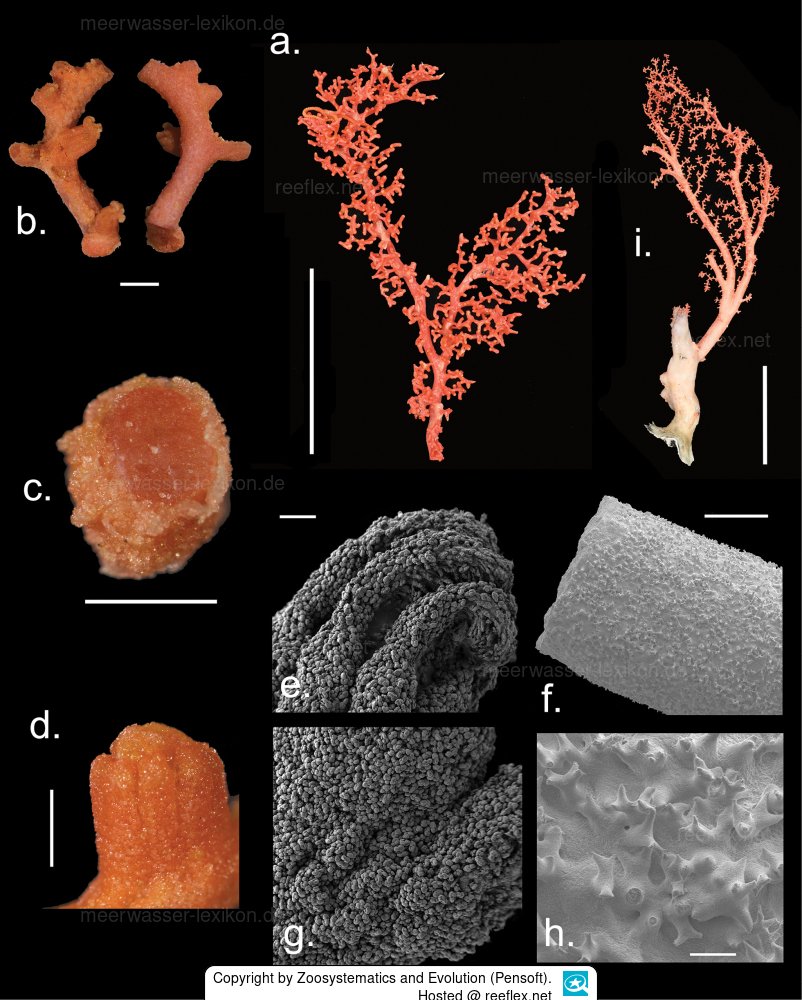Info
The reddish holotype is part of a colony branch with a broken edge on the stem, collected on June 13, 2022 on the Guangde Ridge in the western Indian Ocean at a depth of 1697 meters.
The specimen shown is part of a colony that is almost 22 cm high and whose thickest stem is less than 1 cm in diameter.
Two main branches of the colony exhibit dichotomous branching in a plane with an acute angle.
Branchlets are abundant and mostly arranged in an irregular pinnate pattern on a plane.
Some of them grow at an acute angle, resulting in closely spaced and overlapping branchlets.
A brittle star winds between the branches.
Only the white basal part and the thicker lower branches remain from the paratype.
The branches are bright red, with the color becoming paler towards the base. Autozooids are distributed on small branches over half of the colony level.
Color:
On underwater videos in situ, the live coral appears light pink in color, the base of the colony is white. The fresh coenenchyma and polyps are pale red and turn pink on drying.
Specimens preserved in alcohol retain a pale red color, the axis is then red and the sclerites observed under the microscope appear pale red.
Etymology.
The species name “indicodensum” has been proposed for this new coral.
The name combines “Indico”, derived from “Indicus”, the Latin term for the Indian Ocean, with “densi”, which means “dense” in Latin. This nomenclature reflects both the origin of the species in the vast Indian Ocean and its characteristic, densely branched appearance.
Literature source:
Hu X, Zhang Q, Ge M, Li X, Wang Z, Zhang X, Xu Q (2025)
Two new species of deep-sea Red Corals (Coralliidae, Genus Hemicorallium Gray, 1867) from the western Indian Ocean. Zoosystematics and Evolution
101(1): 317-339. https://doi.org/10.3897/zse.101.139350
This is an open access article distributed under the terms of the Creative Commons Attribution License (CC BY 4.0), which permits unrestricted use, distribution, and reproduction in any medium, provided the original author and source are credited.
The specimen shown is part of a colony that is almost 22 cm high and whose thickest stem is less than 1 cm in diameter.
Two main branches of the colony exhibit dichotomous branching in a plane with an acute angle.
Branchlets are abundant and mostly arranged in an irregular pinnate pattern on a plane.
Some of them grow at an acute angle, resulting in closely spaced and overlapping branchlets.
A brittle star winds between the branches.
Only the white basal part and the thicker lower branches remain from the paratype.
The branches are bright red, with the color becoming paler towards the base. Autozooids are distributed on small branches over half of the colony level.
Color:
On underwater videos in situ, the live coral appears light pink in color, the base of the colony is white. The fresh coenenchyma and polyps are pale red and turn pink on drying.
Specimens preserved in alcohol retain a pale red color, the axis is then red and the sclerites observed under the microscope appear pale red.
Etymology.
The species name “indicodensum” has been proposed for this new coral.
The name combines “Indico”, derived from “Indicus”, the Latin term for the Indian Ocean, with “densi”, which means “dense” in Latin. This nomenclature reflects both the origin of the species in the vast Indian Ocean and its characteristic, densely branched appearance.
Literature source:
Hu X, Zhang Q, Ge M, Li X, Wang Z, Zhang X, Xu Q (2025)
Two new species of deep-sea Red Corals (Coralliidae, Genus Hemicorallium Gray, 1867) from the western Indian Ocean. Zoosystematics and Evolution
101(1): 317-339. https://doi.org/10.3897/zse.101.139350
This is an open access article distributed under the terms of the Creative Commons Attribution License (CC BY 4.0), which permits unrestricted use, distribution, and reproduction in any medium, provided the original author and source are credited.







 Zoosystematics and Evolution (Pensoft)
Zoosystematics and Evolution (Pensoft)











